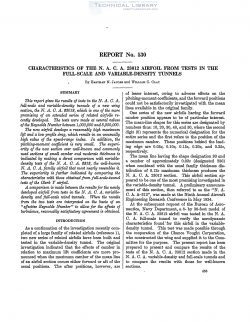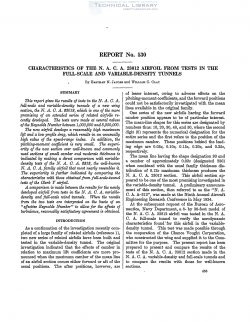naca-report-530

- Version
- 244 Downloads
- 1.17 MB File Size
- 1 File Count
- August 30, 2016 Create Date
- August 30, 2016 Last Updated
National Advisory Committee for Aeronautics, Report - Characteristics of the NACA 23012 Airfoil from Tests in the Full Scale and Variable Density Tunnels

This report gives the results of tests in the N. A. C. A.
full—scale and variable-density tunnels of a new wing
section, the N. A. 0. A. 23012, which is one of the more
promising of an extended series of related airfoils re-
cently developed. The tests were made at several values
of the Reynolds Number between 1,000,000 and 8,000,000.
The new airfoil develops a reasonably high maximum
lift and a low profile drag, which results in an unusually
high value of the speed-range index. In addition, the
pitching-moment coficient is very small. The superi-
ority of the new section over well—known and commonly
used sections of small camber and moderate thickness is
indicated by making a direct comparison with variable-
density tests of the N. A. C. A. 221.9, the well-known
N. A. C. A. family airfoil that most nearly resembles it.
The. superiority is further indicated by comparing the
characteristics with those obtained from full-scale—tunnel
tests of the Clark Y airj’oil.
A comparison is made between the results for the newly
developed airfoil from tests in the N. A. 0. A. variable-
density and full-scale wind tunnels. When the results
from the two tests are interpreted on the basis of an
“efiective Reynolds Number” ‘to allow for the ejects of
turbulence, reasonably satisfactory agreement is obtained.
As a continuation of the investigation recently com—
pleted of a large family of related airfoils (reference 1),
two new series of related airfoils have been built and
tested in the variable-density tunnel. The original
investigation indicated that the effects of camber in
relation to maximum lift coefficients are more pro-
nounced when the maximum camber of the mean line
of an airfoil section occurs either forward or aft of the
usual positions.
| File | Action |
|---|---|
| naca-report-530 Characteristics of the NACA 23012 Airfoil from Tests in the Full Scale and Variable Density Tunnels.pdf | Download |
Comment On This Post